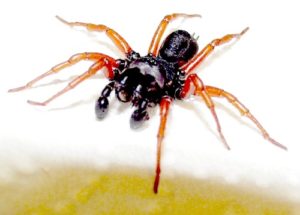
These figures may appear astonishing, but they are true, as claimed by a new study, which reveals that about 27 million tons of spiders eat up nearly 440 – 880 million tons of bugs, insects, springtails, and other invertebrates on an annual basis.
Spiders are arthropods found in almost every part of the world, from deserts to forests and from grasslands to Arctic tundra. Researchers have so far discovered more than 45,000 individual species of spiders. It is estimated that nearly 131 spiders exist per every square meter of land, and the number can increase to up to 1,000 in some areas.
In their study, biologist Martin Nyffeler of the University of Basel in Switzerland and ecologist Klaus Birkhofer of the Brandenburg University of Technology in Germany claim that the annual food consumption of spiders is higher than the 440 million tons of meat and fish consumed by all humans in world in one year.
“By contrast, the annual food consumption of all the world’s seabirds is estimated at 70 million tons,” the researchers write in their study.
“Our calculations let us quantify for the first time on a global scale that spiders are major natural enemies of insects,” said researcher Martin Nyffeler.
“In concert with other insectivorous animals such as ants and birds, they help to reduce the population densities of insects significantly,” he added.
“Spiders thus make an essential contribution to maintaining the ecological balance of nature,” Nyffeler said.
“These estimates emphasize the important role that spider predation plays in semi-natural and natural habitats, as many economically important pests and disease vectors breed in those forest and grassland biomes,” the researchers wrote.
“We hope that these estimates and their significant magnitude raise public awareness and increase the level of appreciation for the important global role of spiders in terrestrial food webs.”
Interesting, conservationists around the world are also trying to save some species of spiders. In June last year, zookeepers at Chessington World of Adventures (CWoA) park in the UK released 400 baby fen raft spiders (Dolomedes plantarius) in the wilds to protect the endangered species from extinction.
Fen raft spiders are the largest of the UK’s 660 spider species and can grow to have a total leg span of almost 8 centimeters. They have brown or black bodies with white or cream stripes along the sides. These spiders are found in fens and other wetlands, and can move across the water surface due to their hairy legs. They eat pond skaters, small spiders, and dragonfly larvae. They can also kill tadpoles and small fish to consume. Female fen raft spiders are known as caring mothers as they build an egg sac for their offspring. The mother spiders then routinely dip into water to keep the sac moist. The mother spiders also spin a nursery web that forms a silk tent over the water for spiderlings, and guard these webs for a couple of days. The Fen raft spiders are listed as an endangered species in the UK because of their declining populations in the UK. There are only three known populations of fen raft spiders in the UK – at Pant-y-Sais Fen and Crymlyn Bog near Swansea, at Redgrave and Lopham Fen in Suffolk, and at Pevensey levels in East Sussex.
In their study, Nyffeler and Birkhofer used data from 65 previous studies to estimate the number of spiders presents in seven biomes on the planet. They estimated that there are about 25 million metric tons of spiders on this planet. With the help of two models, researchers then calculated the amount/number of prey killed by world’s spiders in one year. The researchers took into account of prey needed by most spiders to survive. The average spider biomass per square meter in the various biomes was also considered. The researchers then reached the conclusion that about 400 to 800 million tons of prey killed and consumed by spiders each year.
The detailed findings of the study have been published in the journal The Science of Nature.
